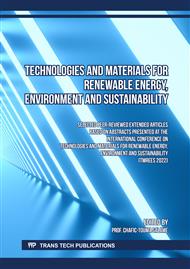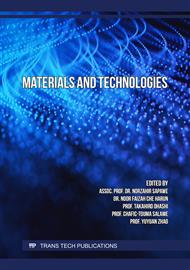[1]
Gunen, A., Ceritbinmez, F., Patel, K., Akhtar, M. A., Mukherjee, S., Kanca, E., & Karakas, M. S. (2022). WEDM machining of MoNbTaTiZr refractory high entropy alloy. CIRP Journal of Manufacturing Science and Technology, 38, 547-559.
DOI: 10.1016/j.cirpj.2022.05.021
Google Scholar
[2]
Arif, Z. U., Khalid, M. Y., ur Rehman, E., Ullah, S., Atif, M., & Tariq, A. (2021). A review on laser cladding of high-entropy alloys, their recent trends and potential applications. Journal of Manufacturing Processes, 68, 225-273.
DOI: 10.1016/j.jmapro.2021.06.041
Google Scholar
[3]
Meghwal, A., Anupam, A., Murty, B.S., Berndt, C.C., Kottada, R.S., & Ang, A. S. M. (2020). Thermal spray high-entropy alloy coatings: a review. Journal of Thermal Spray Technology, 29(5), 857-893.
DOI: 10.1007/s11666-020-01047-0
Google Scholar
[4]
George, E. P., Curtin, W. A., & Tasan, C. C. (2020). High entropy alloys: A focused review of mechanical properties and deformation mechanisms. Acta Materialia, 188, 435-474.
DOI: 10.1016/j.actamat.2019.12.015
Google Scholar
[5]
George, E. P., Raabe, D., & Ritchie, R. O. (2019). High-entropy alloys. Nature reviews materials, 4(8), 515-534.
DOI: 10.1038/s41578-019-0121-4
Google Scholar
[6]
Fayomi, O. S. I., & Akande, I. G. (2019). Corrosion mitigation of aluminium in 3.65% NaCl medium using hexamine. Journal of Bio-and Tribo-Corrosion, 5(1), 1-7.
DOI: 10.1007/s40735-018-0214-4
Google Scholar
[7]
Basu, I., & De Hosson, J. T. M. (2020). Strengthening mechanisms in high entropy alloys: fundamental issues. Scripta Materialia, 187, 148-156.
DOI: 10.1016/j.scriptamat.2020.06.019
Google Scholar
[8]
Zhang, X., Chen, Y., & Hu, J. (2018). Recent advances in the development of aerospace materials. Progress in Aerospace Sciences, 97, 22-34.
DOI: 10.1016/j.paerosci.2018.01.001
Google Scholar
[9]
Patel, N. S., Pavlík, V., & Boca, M. (2017). High-temperature corrosion behavior of superalloys in molten salts–a review. Critical Reviews in Solid State and Materials Sciences, 42(1), 83-97.
DOI: 10.1080/10408436.2016.1243090
Google Scholar
[10]
Sun, Y., Zhang, T., Li, C., Xu, K., & Li, Y. (2020). Compositional engineering of sulfides, phosphides, carbides, nitrides, oxides, and hydroxides for water splitting. Journal of Materials Chemistry A, 8(27), 13415-13436.
DOI: 10.1039/d0ta05038e
Google Scholar
[11]
Schmid, A., Mori, G., Hönig, S., Weil, M., Strobl, S., & Haubner, R. (2018). Comparison of the high-temperature chloride-induced corrosion between duplex steel and Ni based alloy in presence of H2S. Corrosion Science, 139, 76-82.
DOI: 10.1016/j.corsci.2018.04.042
Google Scholar
[12]
Yushchenko, K. A., Zviagintseva, A. V., Kapitanchuk, L. M., & Gakh, I. S. (2018). The role of actively diffusing impurities of sulfur and oxygen in ductility-dip cracking susceptibility of Ni-Cr-Fe welds. Journal of Achievements in Materials and Manufacturing Engineering, 89(2), 49-55.
DOI: 10.5604/01.3001.0012.7108
Google Scholar
[13]
Michi, R. A., Plotkowski, A., Shyam, A., Dehoff, R. R., & Babu, S. S. (2022). Towards high-temperature applications of aluminium alloys enabled by additive manufacturing. International Materials Reviews, 67(3), 298-345.
DOI: 10.1080/09506608.2021.1951580
Google Scholar
[14]
Otitoju, T. A., Okoye, P. U., Chen, G., Li, Y., Okoye, M. O., & Li, S. (2020). Advanced ceramic components: Materials, fabrication, and applications. Journal of industrial and engineering chemistry, 85, 34-65.
DOI: 10.1016/j.jiec.2020.02.002
Google Scholar
[15]
Jiang, S. M., Li, H. Q., Ma, J., Xu, C. Z., Gong, J., & Sun, C. (2010). High temperature corrosion behaviour of a gradient NiCoCrAlYSi coating II: oxidation and hot corrosion. Corrosion Science, 52(7), 2316-2322.
DOI: 10.1016/j.corsci.2010.03.032
Google Scholar
[16]
Muthu, S. M., Bharathi, C. M., Gukhan, N. V., Kumar, S. V., Kannan, M. V., Arivarasu, M., ... & Arivazhagan, N. (2018). Hot Corrosion Studies on Dissimilar Weldments C-22 and AISI 316L in the Molten Salt K2SO4+ 60% wt NaCl Environment. Materials Today: Proceedings, 5(5), 13340-13346.
DOI: 10.1016/j.matpr.2018.02.326
Google Scholar
[17]
Kvasnytska, Y. H., Ivaskevych, L. М., Balytskyi, О. І., Maksyuta, І. І., & Myalnitsa, H. P. (2020). High-Temperature Salt Corrosion of a Heat-Resistant Nickel Alloy. Materials Science, 56(3), 432-440.
DOI: 10.1007/s11003-020-00447-5
Google Scholar
[18]
Ham, G. S., Kim, Y. K., Na, Y. S., & Lee, K. A. (2021). Effect of Ti addition on the microstructure and high-temperature oxidation property of AlCoCrFeNi high-entropy alloy. Metals and Materials International, 27(1), 156-165.
DOI: 10.1007/s12540-020-00708-7
Google Scholar
[19]
Diao, H., Santodonato, L. J., Tang, Z., Egami, T., & Liaw, P. K. (2015). Local structures of high-entropy alloys (HEAs) on atomic scales: An overview. The Journal of the Minerals, Metals and Materials Society, 67(10), 2321-2325.
DOI: 10.1007/s11837-015-1591-5
Google Scholar
[20]
Qiu, Y., Gibson, M. A., Fraser, H. L., & Birbilis, N. (2015). Corrosion characteristics of high entropy alloys. Materials Science and Technology, 31(10), 1235-1243.
DOI: 10.1179/1743284715y.0000000026
Google Scholar
[21]
Liu, Y. X., Cheng, C. Q., Shang, J. L., Rui, W. A. N. G., Peng, L. I., & Jie, Z. H. A. O. (2015). Oxidation behavior of high-entropy alloys AlxCoCrFeNi (x= 0.15, 0.4) in supercritical water and comparison with HR3C steel. Transactions of Nonferrous Metals Society of China, 25(4), 1341-1351.
DOI: 10.1016/s1003-6326(15)63733-5
Google Scholar
[22]
Shi, Y., Yang, B., Xie, X., Brechtl, J., Dahmen, K. A., & Liaw, P. K. (2017). Corrosion of Al xCoCrFeNi high-entropy alloys: Al-content and potential scan-rate dependent pitting behavior. Corrosion Science, 119, 33-45.
DOI: 10.1016/j.corsci.2017.02.019
Google Scholar
[23]
Santodonato, L. J., Zhang, Y., Feygenson, M., Parish, C. M., Gao, M. C., Weber, R. J., ... & Liaw, P. K. (2015). Deviation from high-entropy configurations in the atomic distributions of a multi-principal-element alloy. Nature communications, 6(1), 1-13.
DOI: 10.1038/ncomms6964
Google Scholar
[24]
Seifi, M., Li, D., Yong, Z., Liaw, P. K., & Lewandowski, J. J. (2015). Fracture toughness and fatigue crack growth behavior of as-cast high-entropy alloys. The Journal of the Minerals, Metals and Materials Society, 67(10), 2288-2295.
DOI: 10.1007/s11837-015-1563-9
Google Scholar
[25]
Li, Z., Pradeep, K. G., Deng, Y., Raabe, D., &Tasan, C. C. (2016). Metastable high-entropy dual-phase alloys overcome the strength–ductility trade-off. Nature, 534(7606), 227-230.
DOI: 10.1038/nature17981
Google Scholar
[26]
Duan, H., Wu, Y., Hua, M., Yuan, C., Wang, D., Tu, J., ... & Li, J. (2013). Tribological properties of AlCoCrFeNiCu high-entropy alloy in hydrogen peroxide solution and in oil lubricant. Wear, 297(1-2), 1045-1051.
DOI: 10.1016/j.wear.2012.11.014
Google Scholar
[27]
Nong, Z. S., Lei, Y. N., & Zhu, J. C. (2018). Wear and oxidation resistances of AlCrFeNiTi-based high entropy alloys. Intermetallics, 101, 144-151.
DOI: 10.1016/j.intermet.2018.07.017
Google Scholar
[28]
Joseph, J., Haghdadi, N., Shamlaye, K., Hodgson, P., Barnett, M., & Fabijanic, D. (2019). The sliding wear behaviour of CoCrFeMnNi and AlxCoCrFeNi high entropy alloys at elevated temperatures. Wear, 428, 32-44. #.
DOI: 10.1016/j.wear.2019.03.002
Google Scholar
[29]
Fayomi, O. S. I., Akande, I. G., Oluwole, O. O., & Daramola, D. (2018). Effect of water-soluble chitosan on the electrochemical corrosion behaviour of mild steel. Chemical Data Collections, 17, 321-326.
DOI: 10.1016/j.cdc.2018.10.006
Google Scholar
[30]
Zhou, Z., Liu, B., Guo, W., Fu, A., Duan, H., & Li, W. (2021). Corrosion behavior and mechanism of FeCrNi medium entropy alloy prepared by powder metallurgy. Journal of Alloys and Compounds, 867, 159094, 1-9.
DOI: 10.1016/j.jallcom.2021.159094
Google Scholar
[31]
Lattanzi, L., Fabrizi, A., Fortini, A., Merlin, M., & Timelli, G. (2017). Effects of microstructure and casting defects on the fatigue behavior of the high-pressure die-cast AlSi9Cu3 (Fe) alloy. Procedia Structural Integrity, 7, 505-512.
DOI: 10.1016/j.prostr.2017.11.119
Google Scholar
[32]
Cao, L., Sun, F., Chen, T., Tang, Y., & Liao, D. (2018). Quantitative prediction of oxide inclusion defects inside the casting and on the walls during cast-filling processes. International Journal of Heat and Mass Transfer, 119, 614-623.
DOI: 10.1016/j.ijheatmasstransfer.2017.11.127
Google Scholar
[33]
Das, S., & Robi, P. S. (2020). A novel refractory WMoVCrTa high-entropy alloy possessing fine combination of compressive stress-strain and high hardness properties. Advanced Powder Technology, 31(12), 4619-4631.
DOI: 10.1016/j.apt.2020.10.008
Google Scholar
[34]
Barron, P. J., Carruthers, A. W., Fellowes, J. W., Jones, N. G., Dawson, H., & Pickering, E. J. (2020). Towards V-based high-entropy alloys for nuclear fusion applications. Scripta Materialia, 176, 12-16.
DOI: 10.1016/j.scriptamat.2019.09.028
Google Scholar
[35]
Nam, H., Park, C., Moon, J., Na, Y., Kim, H., & Kang, N. (2019). Laser weldability of cast and rolled high-entropy alloys for cryogenic applications. Materials Science and Engineering: A, 742, 224-230.
DOI: 10.1016/j.msea.2018.11.009
Google Scholar
[36]
Xu, Q., Chen, D., Tan, C., Bi, X., Wang, Q., Cui, H., ... & Chen, R. (2021). NbMoTiVSix refractory high entropy alloys strengthened by forming BCC phase and silicide eutectic structure. Journal of Materials Science & Technology, 60, 1-7.
DOI: 10.1016/j.jmst.2020.04.050
Google Scholar
[37]
George, E. P., Raabe, D., & Ritchie, R. O. (2019). High-entropy alloys. Nature Reviews Materials, 4(8), 515-534.
DOI: 10.1038/s41578-019-0121-4
Google Scholar
[38]
Fan, Z., Zhong, W., Jin, K., Bei, H., Osetsky, Y. N., & Zhang, Y. (2021). Diffusion-mediated chemical concentration variation and void evolution in ion-irradiated NiCoFeCr high-entropy alloy. Journal of Materials Research, 36(1), 298-310.
DOI: 10.1557/s43578-020-00071-8
Google Scholar
[39]
Sogabe, R., Goto, Y., Abe, T., Moriyoshi, C., Kuroiwa, Y., Miura, A., ... & Mizuguchi, Y. (2019). Improvement of superconducting properties by high mixing entropy at blocking layers in BiS2-based superconductor REO0. 5F0. 5BiS2. Solid State Communications, 295, 43-49.
DOI: 10.1016/j.ssc.2019.04.001
Google Scholar
[40]
Hsiao, Y. T., Tung, C. H., Lin, S. J., Yeh, J. W., & Chang, S. Y. (2020). Thermodynamic route for self-forming 1.5 nm V-Nb-Mo-Ta-W high-entropy alloy barrier layer: Roles of enthalpy and mixing entropy. Acta Materialia, 199, 107-115.
DOI: 10.1016/j.actamat.2020.08.029
Google Scholar
[41]
Wei, S., Kim, S. J., Kang, J., Zhang, Y., Zhang, Y., Furuhara, T., ... & Tasan, C. C. (2020). Natural-mixing guided design of refractory high-entropy alloys with as-cast tensile ductility. Nature Materials, 19(11), 1175-1181.
DOI: 10.1038/s41563-020-0750-4
Google Scholar
[42]
Xiang, S., Luan, H., Wu, J., Yao, K. F., Li, J., Liu, X., ... & Li, Q. (2019). Microstructures and mechanical properties of CrMnFeCoNi high entropy alloys fabricated using laser metal deposition technique. Journal of Alloys and Compounds, 773, 387-392.
DOI: 10.1016/j.jallcom.2018.09.235
Google Scholar
[43]
Fall, A., Monajati, H., Khodabandeh, A., Fesharaki, M. H., Champliaud, H., & Jahazi, M. (2019). Local mechanical properties, microstructure, and microtexture in friction stir welded Ti-6Al-4V alloy. Materials Science and Engineering: A, 749, 166-175.
DOI: 10.1016/j.msea.2019.01.077
Google Scholar
[44]
Cornide, J., Dahlborg, U., Leong, Z., Dominguez, L. A., Juraszek, J., Jouen, S., ... & Calvo-Dahlborg, M. (2015). Structure and Properties of Some CoCrFeNi-Based High Entropy Alloys. TMS 2015 144th Annual Meeting & Exhibition, 1147-1155.
DOI: 10.1007/978-3-319-48127-2_139
Google Scholar
[45]
Holder, C. F., & Schaak, R. E. (2019). Tutorial on powder X-ray diffraction for characterizing nanoscale materials. ACS Nano , 13 (7) 7359–7365.
DOI: 10.1021/acsnano.9b05157
Google Scholar
[46]
Akpan, B. J., Akande, I. G., Fayomi, O. S. I., & Oluwasegun, K. M. (2022). Investigation of hardness, microstructure and anti-corrosion properties of Zn-ZnO composite coating doped unripe plantain peel particles. Case Studies in Chemical and Environmental Engineering, 5, 1-7.
DOI: 10.1016/j.cscee.2022.100187
Google Scholar
[47]
Himabindu, B., Devi, N. L., & Kanth, B. R. (2021). Microstructural parameters from X-ray peak profile analysis by Williamson-Hall models; A review. Materials Today: Proceedings, 47, 4891-4896.
DOI: 10.1016/j.matpr.2021.06.256
Google Scholar
[48]
Feijoo, I., Cabeza, M., Merino, P., Pena, G., Perez, M. C., Cruz, S., & Rey, P. (2019). Estimation of crystallite size and lattice strain in nano-sized TiC particle-reinforced 6005A aluminium alloy from X-ray diffraction line broadening. Powder Technology, 343, 19-28.
DOI: 10.1016/j.powtec.2018.11.010
Google Scholar
[49]
Sathiyamoorthi, P., Basu, J., Kashyap, S., Pradeep, K. G., & Kottada, R. S. (2017). Thermal stability and grain boundary strengthening in ultrafine-grained CoCrFeNi high entropy alloy composite. Materials & Design, 134, 426-433.
DOI: 10.1016/j.matdes.2017.08.053
Google Scholar
[50]
Winnicki, M., Małachowska, A., Baszczuk, A., Rutkowska-Gorczyca, M., Kukla, D., Lachowicz, M., & Ambroziak, A. (2017). Corrosion protection and electrical conductivity of copper coatings deposited by low-pressure cold spraying. Surface and Coatings Technology, 318, 90-98.
DOI: 10.1016/j.surfcoat.2016.12.101
Google Scholar



